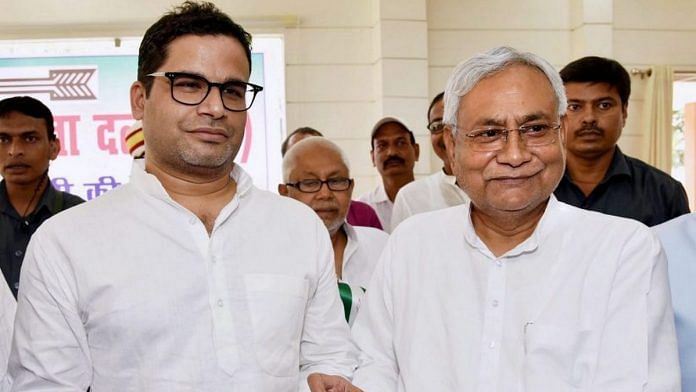Nitish Kumar’s No.2, who has worked with both Narendra Modi and Rahul Gandhi, will be crucial to Bihar CM’s plans in 2019.
New Delhi: Poll strategist Prashant Kishor’s appointment Tuesday as Janata Dal (United) vice-president, the No.2 in Bihar’s ruling party, has got the political circles buzzing: What is it that makes him so special?
For someone who met Bihar Chief Minister Nitish Kumar for the first time barely four years ago, Kishor has certainly had a meteoric rise in politics.
His appointment comes just a month after his transition from a strategist to politician when he joined the JD(U).
‘Younger brother’
Kishor met Kumar at his friend and diplomat-turned-politician Pavan K. Varma’s residence in New Delhi in November 2014. The two gelled immediately and the rest is history.
Kishor went on to architect the mahagathbandhan or grand alliance of the JD(U), the Rashtriya Janata Dal and the Congress, which trounced the National Democratic Alliance (NDA) in the 2015 Bihar assembly elections.
Also read: With stage set for 2019, Prashant Kishor is back in the game
Kumar then appointed him his advisor with a Cabinet rank. Such was the equation between the two that even after Kishor left Kumar to work with the Congress in Uttar Pradesh and Punjab assembly elections — and later with Jagan Mohan Reddy’s YSR Congress in Andhra Pradesh — he continued to have his room in the chief minister’s official residence in Patna.
JD(U) leaders say that Kumar treats him “like his younger brother”.
Friends on all sides
Kishor is known to hit it off instantly with ambitious politicians.
He met Narendra Modi during a visit to Gujarat in 2011 in his capacity as a public health expert working with the United Nations. The then chief minister engaged him soon to plan his campaign for the 2012 assembly elections.
Kishor later founded the Citizens for Accountable Governance (CAG), a non-profit organisation, and involved young professionals to play a crucial role in Modi’s ascension to power in New Delhi.
Even when he quit the BJP to join the opposition grouping, he continued to enjoy a good rapport with Modi. The CAG was expected to be given a role in governance in implementing the vision that Modi laid out before the country in the run up to the Lok Sabha polls but some top functionaries of the BJP apparently grew restless and scuttled the plan.
Kishor also hit it off well with Rahul Gandhi and Priyanka Vadra. But he parted ways with the party soon as Congressmen were too obsessed with conventional politics to experiment with anything new.
Why Kumar needs Kishor
However, it’s not just personal chemistry that has led to Kishor’s anointment as Nitish Kumar’s deputy in the JD(U). A shrewd politician that Kumar is, he can’t but notice the signs of trouble for him. His projection as a ‘vikas purush’, or development man, of Bihar is fast unravelling.
Also read: Spin doctor Prashant Kishor’s task has been to give Jagan a softer, family-friendly face
NITI Aayog CEO Amitabh Kant recently named Bihar among the states that are keeping India backward, especially on social indicators. Although the JD(U)-BJP government has been tom-toming the double-digit growth figures, the state is making headlines for all the wrong reasons — Muzaffarpur shelter home rape cases, law and order problems, corruption and unemployment.
Bihar ranked the lowest in the Public Affairs Index, released in July by Bengaluru-based think tank Public Affairs Centre, which ranks states on governance based on official data pertaining to social and economic development.
Kumar needs to repackage himself and Kishor has proven credentials on this front. He was said to be the brain behind Modi’s ‘chai pe charcha’ outreach, 3D hologram campaign and other innovative strategies to create a larger-than-life image of him in the run up to the 2014 general elections.
Kishor with his network of friends across the political spectrum would be the Bihar chief minister’s key man in the run up to and post-Lok Sabha elections.
To start with, the JD(U), which could win only 2 of the 40 Lok Sabha seats in the state in 2014, is bargaining hard with the BJP for a ‘respectable’ share of seats in the next general elections. Kishor’s favourable equations with Modi should come handy in seat-sharing talks with the saffron party.
JD(U) leaders say that Kumar is also keen on advancing the assembly election to hold it simultaneously with the Lok Sabha elections. The idea is to preempt the saffron party that sees potential for further expansion in Bihar.
If the BJP were to return to power in 2019, the party would be inclined to leverage it by going solo in the assembly polls the next year, believe a section of JD(U) leaders. The JD(U) could preempt it by holding simultaneous polls, with Kumar as the chief ministerial candidate.
Kishor’s equations with non-BJP parties could be equally helpful for Kumar in the event of a fractured mandate in 2019 Lok Sabha elections.
Kumar has managed to be in power — either as a Union Minister or Chief Minister— since 1998, except for short intervals. He seems to be banking on Kishor now to ensure it in future too.






